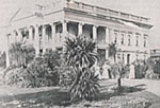
Australian residential architectural styles
Encyclopedia

- Pre-Colonial Period 30,000 BCE - 1788 CE
- Old Colonial Period 1788 - c. 1840
- Victorian Period c. 1840 - c. 1890
- Federation Period c. 1890 - c. 1915
- Inter-War Period c. 1915 - c. 1940
- Post-War Period c. 1940–1960
- Late 20th Century 1960–2000
- 21st century 2001 --
Pre-Colonial Period 30,000 BCE - 1788 CE
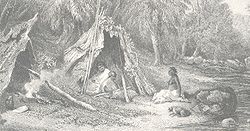
Australia
Australia , officially the Commonwealth of Australia, is a country in the Southern Hemisphere comprising the mainland of the Australian continent, the island of Tasmania, and numerous smaller islands in the Indian and Pacific Oceans. It is the world's sixth-largest country by total area...
are traditionally largely nomadic, ranging over an area, depending on the availability of particular foodstuffs that could be gathered at different times of the year. They managed the land through which they travelled by biennial burning-off which stunted the growth of forests and encourage grassland from which seed crops and kangaroos could be harvested.
The housing of the people first encountered by Europeans in the Sydney region were simple shelters constructed of a semicircle of stick, covered with large sheets of bark which could be conveniently stripped off Melaleuca
Melaleuca
Melaleuca is a genus of plants in the myrtle family Myrtaceae known for its natural soothing and cleansing properties. There are well over 200 recognised species, most of which are endemic to Australia...
trees which grew profusely along waterways (commonly known as "Wurlies"). Other types of simple structures were seen including lean-tos and in tropical regions raised sleeping platforms. Grass, leaves and reeds were used as a thatch where suitable bark was not available.
There are isolated instances of indigenous peoples constructing partially using dry-stone wall techniques in Western Australia
Western Australia
Western Australia is a state of Australia, occupying the entire western third of the Australian continent. It is bounded by the Indian Ocean to the north and west, the Great Australian Bight and Indian Ocean to the south, the Northern Territory to the north-east and South Australia to the south-east...
. The Aboriginal people also built dry-stone Fish Traps, of which the most extensive, ranging over 500 metres, is on the Barwon River
Barwon River (New South Wales)
The Barwon River flows through New South Wales, virtually as a continuation of the Macintyre River / Border Rivers system, before joining with the Culgoa River to form the Darling River...
at Brewarrina
Brewarrina, New South Wales
Brewarrina is a small town in North West New South Wales, Australia on the banks of the Barwon River in Brewarrina Shire. It is 98 km east of Bourke and west of Walgett on the Kamilaroi Highway, and 808 km from Sydney. Brewarrina has had its population decrease from 1,197 persons in...
. Its age is unknown. It has been maintained and rebuilt after floods many times and is said traditionally to have been given to the local tribes by the Creator Spirit
Baiame
In Australian Aboriginal mythology Baiame was the Creator God and Sky Father in the dreaming of several language groups , of Indigenous Australians of South-East Australia....
.
It appears that in conjunction with such catchment schemes, there may have also been nearby sedentary settlements of people who maintained them. There is evidence at Lake Condah in Victoria of houses in conjunction with eel traps dating back about 8,000 years.
In January 2006, bushfires uncovered another nearby site of a village of stone houses that are large enough to have provided sleeping space for several families.
Old Colonial Period 1788 - c. 1840
Colonial Architecture is the term used for the buildings constructed in Australia between European settlement in January 1788 and about 1840.The first buildings of the British penal settlement in Sydney were a prefabricated house for the Governor and a similarly prefabricated Government Store to house the colony's supplies. Sydney was a tent settlement. Building anything more substantial was made unnecessarily difficult by the poor quality of spades and axes that had been provided and the shortage of nails.
The convicts adapted simple country techniques commonly used for animal shelters and the locally available materials to create huts with wattle-and-daub walls. So useful were the local acacia
Acacia
Acacia is a genus of shrubs and trees belonging to the subfamily Mimosoideae of the family Fabaceae, first described in Africa by the Swedish botanist Carl Linnaeus in 1773. Many non-Australian species tend to be thorny, whereas the majority of Australian acacias are not...
trees for weaving shelters that they were given the name Wattle. Some pipe clay was obtained from the coves around Port Jackson
Port Jackson
Port Jackson, containing Sydney Harbour, is the natural harbour of Sydney, Australia. It is known for its beauty, and in particular, as the location of the Sydney Opera House and Sydney Harbour Bridge...
. Bricks were fired in wood fires and were therefore soft. Lime for cement was obtained by burning oyster shells.
The first imported roofing material was corrugated iron sheeting. Roofs of this type were to become part of the Australian vernacular. For many years imported roofing was in very short supply. Two local roofing materials were available- there were extensive reed beds near the Cook's river for thatching. There was also bark which could be peeled off a number of the indigenous trees in large sheets. Methods of heating and flattening the bark were used by the Aboriginal people and these were quickly assimilated by the convict builders.
The two most significant trees, both of which grew in the Sydney area, were the Melaleuca and the Iron Bark. The Melaleuca bark, having the texture of paper, could be peeled off the tree in layers up to 2 cm thick, a metre long and perhaps half a metre wide without serious damage to the tree. Although not particularly durable as exterior roofing, the material provided excellent insulation and was used for ceilings and lining the walls.
The resilient bark from the Iron-bark tree was adapted as a major building material everywhere that such trees grew. It was widely used as a roofing material, was weatherproof, insulating and could last for thirty years. Houses of axe-hewn slabs
Slab Hut
A Slab Hut is a kind of dwelling or shed made from slabs of split or sawn timber. It was a common form of construction used by settlers in Australia and New Zealand during their nations' Colonial periods.-The Australian Settler:...
with Iron-bark roofs continued to be built in rural Australia until WWII.
As better tools became available the Colonial builders became adept at working the extremely hard and durable timber of the native hardwood forests. The majority of houses were built of split logs rather than sawn timber. The technique employed for the construction of a wall was to chisel out a deep groove in a straight log, preferably of the local termite-resistant Cyprus pine which became the foundation. Split logs that had been adzed flat at the ends were then stood in the groove and another groove log was placed on top and slotted into place in a circular corner post. The gaps between the split logs were either packed with clay and animal hair or had narrow strips of metal cut from kerosene tins tacked over them. The interior could be plastered with clay, lined with paperbark or papered with newspaper, wrapping paper or calico. Cards, photographs, news clippings and commemorative items were often stuck directly onto the walls.
The technique of making durable hardwood roofing shingles was also developed. Where these shingles have been applied to brick houses, they have sometimes survived to the 21st century, covered by subsequent corrugated iron roofs.
In the earliest houses windows were usually small, and multi-paned with cylinder glass. When the cost of glass put it beyond reach of the home-owner, blinds of oiled calico were tacked across window openings in the winter months.
Types of buildings
The simplest houses were of a single room, which, if the bread-winner prospered, became the kitchen to a more substantial residence, or conversely, became the living room with a lean-to kitchen added. Houses that grew piecemeal were generally asymmetrical, with the door leading into the original room.
Houses that were planned were generally symmetrical, and very simple, usually containing 2 to 4 rooms around a central hallway. The kitchen was frequently detached and entered from a rear verandah or covered breezeway where pantry or scullery might also be located. Fireplaces projected outwards from the walls of the house. Except in the case of some small inner-city Georgian row houses built of brick, houses generally had a verandah added to them, often on three sides.
One class of people who maintained the tradition of wattle and daub, with a bark roof was the squatters who did not have title to their land, and potentially had to move on every two years.
Very few 19th century houses of wattle and daub or split timber have survived. A small number of split timber cottages which later became kitchens may be seen adjacent to more substantial homes, generally painted to match the house and barely recognizable.
Most buildings erected in the first 50 years of Australian settlement were simple and plain. Convict huts, marine barracks, government stores and houses for officials were simple rectangular prisms covered with hipped or gabled roofs often with verandahs supported on wooden columns in the Classical manner. They were influenced in particular by the regulation British military buildings in India and other tropical locations.
At the time of the first settlement, Georgian architecture
Georgian architecture
Georgian architecture is the name given in most English-speaking countries to the set of architectural styles current between 1720 and 1840. It is eponymous for the first four British monarchs of the House of Hanover—George I of Great Britain, George II of Great Britain, George III of the United...
was the architectural vernacular in Britain. Craftsmen, including carpenters and plasterers were trained in the classic proportions associated with the Palladian style
Palladian architecture
Palladian architecture is a European style of architecture derived from the designs of the Venetian architect Andrea Palladio . The term "Palladian" normally refers to buildings in a style inspired by Palladio's own work; that which is recognised as Palladian architecture today is an evolution of...
fashionable across Europe. Palladian ideals reveal themselves in some of the few larger homes of the Regency period such as “Elizabeth Bay House”. Neoclassism
Neoclassical architecture
Neoclassical architecture was an architectural style produced by the neoclassical movement that began in the mid-18th century, manifested both in its details as a reaction against the Rococo style of naturalistic ornament, and in its architectural formulas as an outgrowth of some classicizing...
incorporating not only Greek
Greeks
The Greeks, also known as the Hellenes , are a nation and ethnic group native to Greece, Cyprus and neighboring regions. They also form a significant diaspora, with Greek communities established around the world....
but also sometimes Ancient Egypt
Ancient Egypt
Ancient Egypt was an ancient civilization of Northeastern Africa, concentrated along the lower reaches of the Nile River in what is now the modern country of Egypt. Egyptian civilization coalesced around 3150 BC with the political unification of Upper and Lower Egypt under the first pharaoh...
ian motifs
Motif (art)
In art, a motif is an element of a pattern, an image or part of one, or a theme. A motif may be repeated in a design or composition, often many times, or may just occur once in a work. A motif may be an element in the iconography of a particular subject or type of subject that is seen in other...
, beginning in Europe about 1760, also influenced Australian architectural style. “Fernhill” at Mulgoa with its wide colonnaded verandah shows the influence of Neoclassicism.
As the Australian economy developed and settlements became more established, more sophisticated buildings emerged.
Victorian Period c. 1840 - c. 1890
- Gothic Revival
1840–1880
The British Empire
British Empire
The British Empire comprised the dominions, colonies, protectorates, mandates and other territories ruled or administered by the United Kingdom. It originated with the overseas colonies and trading posts established by England in the late 16th and early 17th centuries. At its height, it was the...
, of which Australia was an integral part, was heavily influenced by the Anglican religion
Religion
Religion is a collection of cultural systems, belief systems, and worldviews that establishes symbols that relate humanity to spirituality and, sometimes, to moral values. Many religions have narratives, symbols, traditions and sacred histories that are intended to give meaning to life or to...
. In turn this was influenced by the 19th century teachings of the Oxford
Oxford Movement
The Oxford Movement was a movement of High Church Anglicans, eventually developing into Anglo-Catholicism. The movement, whose members were often associated with the University of Oxford, argued for the reinstatement of lost Christian traditions of faith and their inclusion into Anglican liturgy...
and Cambridge Movement
Cambridge Movement
The Cambridge Movement was a conservative ideological school of thought closely related to the Oxford Movement.- History :It has been claimed the origins of the movement emanate from the teachings of the Cambridge University professor and intellectual Desiderius Erasmus...
s which believed Gothic architecture
Gothic architecture
Gothic architecture is a style of architecture that flourished during the high and late medieval period. It evolved from Romanesque architecture and was succeeded by Renaissance architecture....
to be the purest, truest form. According to these English movements, this was the only way to achieve spiritual communication with God through architecture. Thus, while a local magnate
Magnate
Magnate, from the Late Latin magnas, a great man, itself from Latin magnus 'great', designates a noble or other man in a high social position, by birth, wealth or other qualities...
may have built his home in a classical style, he would fund a church in the Gothic style. Thus, during the 19th century, when Australia was expanding rapidly, two forms of architecture were very evident: Gothic and the Classical styles. Originally Gothic was for God, and the Classical for the man. Later a new "self-made" Australian began to emerge, unhindered by a classical British education dictating classical gentlemanly interests. This "new" self-made man (like his contemporaries in Britain) would often choose Gothic as the design for his home.
The great cathedrals of the Middle Ages
Middle Ages
The Middle Ages is a periodization of European history from the 5th century to the 15th century. The Middle Ages follows the fall of the Western Roman Empire in 476 and precedes the Early Modern Era. It is the middle period of a three-period division of Western history: Classic, Medieval and Modern...
during the Gothic Period of ecclesiastical architecture formed the inspiration for this particular architectural style; not only in residential buildings, but in many commercial structures, churches and cathedrals built during this time. St. Paul's and St. Patrick's Cathedrals in Melbourne
Melbourne
Melbourne is the capital and most populous city in the state of Victoria, and the second most populous city in Australia. The Melbourne City Centre is the hub of the greater metropolitan area and the Census statistical division—of which "Melbourne" is the common name. As of June 2009, the greater...
are excellent examples of the Gothic Revival Period, often referred to as Victorian Gothic. Characteristics were: steeply pitched roofs often made of slate, narrow doors and windows resolving in a Gothic pointed arch at their height (known as lancet window
Lancet window
A lancet window is a tall narrow window with a pointed arch at its top. It acquired the "lancet" name from its resemblance to a lance. Instances of this architectural motif are most often found in Gothic and ecclesiastical structures, where they are often placed singly or in pairs.The motif first...
s), diamond pane glazing to windows imitating a stained glass affect, and intricate parapets, often of a religious nature, with a cross. In non-terrace houses, the drawing room was often pulled forward, adding a bay window to the front of the dwelling.
- Early, Mid and Late Victorian
1845–1900
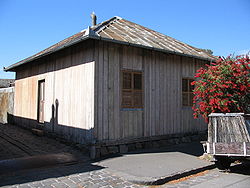
Victorian architecture
The term Victorian architecture refers collectively to several architectural styles employed predominantly during the middle and late 19th century. The period that it indicates may slightly overlap the actual reign, 20 June 1837 – 22 January 1901, of Queen Victoria. This represents the British and...
style in Australia can be divided into 3 periods: Early, Mid and Late. The period in its entirety stretches from 1837 to 1901 and was named after the then Queen, Queen Victoria. Early styles featured symmetrical layouts and façades, a centrally located front door and a hipped roof of corrugated iron, leading to a veranda on the façade. During the 1850s cast-iron lacework came to Australia, where it made its way on to Mid and Late Victorian Homes with much the same floor plan as the Colonial Style, a central hallway with a standard 4 rooms. Weatherboards were often used, although larger homes used red brick and blue stone. In the Mid Victorian Style, decoration began to gain popularity. The bullnosed veranda roof was introduced, sidelights were added either side of the front door, and terraced houses were springing up everywhere, containing parapets and detailed dividing walls between the property boundaries. Late Victorian Style homes had perhaps the most decorative features in all of the known architectural styles to date, which is often referred to as Boom Style. Towards the end of the Victorian era, timber fretwork was being used more and more, which led into the Edwardian/Federation Styles.
From the 1840s, a specific style of building emerged in Queensland
Queensland
Queensland is a state of Australia, occupying the north-eastern section of the mainland continent. It is bordered by the Northern Territory, South Australia and New South Wales to the west, south-west and south respectively. To the east, Queensland is bordered by the Coral Sea and Pacific Ocean...
. The Queenslander
Queenslander (architecture)
Queenslander architecture is a modern term for the vernacular type of architecture of Queensland, Australia. It is also found in the northern parts of the adjacent state of New South Wales and shares many traits with architecture in other states of Australia but is distinct and unique...
style of houses are identifiable by large verandahs and large double doors which open onto these verandahs, stilts rising the house above ground level (particularly in older houses), metal roofs typically of corrugated design and the houses are always constructed of mostly wood.
The styles during this period were: Georgian, Regency, Egyptian, Academic Classical, Free Classical, Filligree, Mannerist, Second Empire, Italianate, Romanesque, Academic Gothic, Free Gothic, Tudor, Rustic Gothic and Carpenter Gothic. Of these fifteen styles, the following seven were normally used for residential architecture:
Georgian
A typical Georgian house of the 19th century was simple, elegant and formal in style.Regency
The Regency style was a refinement of Georgian, with elaborations like a portico with columns at the front of the house.Filigree
As housing developed in Australia, verandas became important as a way of shading the house. From the mid-19th century in particular, as people became more affluent, they built more elaborate homes, and one of the favoured elaborations was the filigree, or screen, of cast ironCast iron
Cast iron is derived from pig iron, and while it usually refers to gray iron, it also identifies a large group of ferrous alloys which solidify with a eutectic. The color of a fractured surface can be used to identify an alloy. White cast iron is named after its white surface when fractured, due...
or wrought iron
Wrought iron
thumb|The [[Eiffel tower]] is constructed from [[puddle iron]], a form of wrought ironWrought iron is an iron alloy with a very low carbon...
. This developed to the point where it has become one of the major features of Australian architecture.
Italianate
The Italianate style developed as a result of French painters who idealised the Italian landscape and turned it into their version of Arcadia. Their influence was long-lasting and eventually led to the Italianate architectural style of the 19th century. The style featured asymmetry and, usually, a tower of varying size. In Australia, the addition of the verandah, sometimes arcaded but later in Filigree gave a regional flavour to the style.Free Gothic
The Gothic style gained favour from the early days of Queen Victoria's reign. Free Gothic became a popular choice for architects and their clients because it was not concerned with historical correctness and therefore gave them greater freedom in their designs. The style was much in vogue for religious buildings but was sometimes used in residential architecture as well.Tudor
The Tudor style grew out of a nostalgia for things Old English, particularly focused on the days of Queen Elizabeth I and Henry VIII. Its role in Australia began when the English architect Edward Blore designed Government House in Sydney in 1834. The style spread all over Australia and also influenced later styles like Federation Queen Anne and Inter-War Old English.Rustic Gothic
The Rustic Gothic style developed out of a "cult of the picturesque" which largely focused on rural images and especially the picturesque "rustic house", which became known as the cottage orne. In Australia, this style had a great appeal to British settlers who still carried with them a hankering for things English.Second Empire
Second Empire was preferred for grander mansions. For the rich, particularly in the wealthier parts of the larger metropolitan areas, the style evoked images of French aristocracy. Although rare, examples can be found in the bigger cities. Distinctive features include towers, quoining, mansard and slate roofs, square domes dormer windows, iron cresting and rich classical details. In the Australian setting, domestic interpretations of the style often combined filigree elements such as cast iron verandahs.Federation period c. 1890 - c. 1915
The Edwardian Style was named after King EdwardEdward VII of the United Kingdom
Edward VII was King of the United Kingdom and the British Dominions and Emperor of India from 22 January 1901 until his death in 1910...
(1901–1910) at the time, and the term Federation coincided with Australia becoming a nation of its own in 1901
Federation of Australia
The Federation of Australia was the process by which the six separate British self-governing colonies of New South Wales, Queensland, South Australia, Tasmania, Victoria and Western Australia formed one nation...
. Thus, the Federation style was, broadly speaking, the Australian version of the Edwardian, but differed from the Edwardian in the use of Australian motifs, like Kangaroos, the Rising Sun (of Federation), and Emus. The names all indicated very similar styles with features so minute separating them. Cream painted decorative timber features, tall chimneys and fretwork
Fretwork
Fretwork is an interlaced decorative design that is either carved in low relief on a solid background, or cut out with a fretsaw, coping saw, jigsaw or scroll saw. Most fretwork patterns are geometric in design. The materials most commonly used are wood and metal. Fretwork is used to adorn...
. Federation depicted a Tudor
Tudorbethan architecture
The Tudor Revival architecture of the 20th century , first manifested itself in domestic architecture beginning in the United Kingdom in the mid to late 19th century based on a revival of aspects of Tudor style. It later became an influence in some other countries, especially the British colonies...
type look, especially on gables
Gables
Gables may refer to:* Gables, portion of walls between the lines of sloping roofs* Ken Gables , Major League Baseball pitcher* Gables, Nebraska, an unincorporated community in the United States...
, and Edwardian gave a simpler cottage look.
This style was, in fact, the Federation version of the Queen Anne style. Other styles during this period were Federation Academic Classical, Federation Free Classical, Federation Filligree, Federation Anglo-Dutch, Federation Romanesque, Federation Gothic, Federation Carpenter Gothic, Federation Warehouse, Federation Free Style, Federation Arts and Crafts and Federation Bungalow. Out of the twelve Federation styles, however, only the following four were normally used in residential architecture:
Federation Arts and Crafts
The Arts and Crafts style came out of a movement to get away from mass-production and rediscover the human touch and the hand-made. The architectural style was characterised by pebble walls, shingles, faceted bay windows, stone bases and tall chimneys. It was widely used in Australia during the Federation period.Federation Bungalow
The bungalow style was usually a single-storey house with a prominent veranda, especially with the roof covering the veranda. It is seen as a transition phase between the Federation period and the California bungalow.Federation Filigree
The filigree style was characterised by the creation of a screen as a prominent style at the front of the house. In the Victorian period, the screen was made of wrought iron, but in the Federation period it was made of wooden fretwork, which could be quite elaborate. It was widely used in Queensland as a way of providing shade and circulation of air for a home.Inter-War Period c. 1915 - c. 1940
Styles which existed during the 1915-40 period include Georgian Revival, Academic Classical, Free Classical, Mediterranean, Spanish Mission, Art-Deco, Skyscraper Gothic, Romanesque, Gothic and Old English.Californian Bungalow
1915–1940This style can almost instantly be recognised by the columns holding up a front veranda area. The name is almost self-explanatory: bungalow, a rugged type of home. This led to the belief that picket fences looked appropriate at the front fence, although originally they were not used. Darker colours were originally used but, as the years went by, new brighter paint served as a welcoming change to open up the spaces and brighten up the homes. Stone, brick and timber, earthy materials were used. A gable roof faced either the front or side always.
Ashgrovian
1930 onwardsOriginally specific to Queensland, the [Ashgrovian style developed from the hipped bungalow style and was characterised by a frontage with a grand gable roof, often surrounded by secondary smaller gables behind, the smaller gables usually sheltering verandahs and sleep-outs. A staircase almost always dominated the front yard leading to the verandah.
Spanish Mission
1925–1939Distinctly recognised by twisted pylons to a porch area covering the front door, usually windows grouped in threes to the side of the front door area on simpler homes. The style was influenced by the American Spanish inhabitant influenced American Architectural styles. Walls were brick in accordance with council regulations at the time, with white or cream yellowish cream stucco
Stucco
Stucco or render is a material made of an aggregate, a binder, and water. Stucco is applied wet and hardens to a very dense solid. It is used as decorative coating for walls and ceilings and as a sculptural and artistic material in architecture...
finish and Spanish terra cotta tiles.
Old English
1915–1940The Old English style involved a certain nostalgia for English ways, and tended to draw on Tudor and such-like English styles harking back vaguely to the days of Henry VIII. It had a certain appeal for what was still a predominantly Anglo-Saxon population at the time.
Early Moderne
1930–1940A very modern looking style at the time, inspired by a German movement known as Bauhaus
Bauhaus
', commonly known simply as Bauhaus, was a school in Germany that combined crafts and the fine arts, and was famous for the approach to design that it publicized and taught. It operated from 1919 to 1933. At that time the German term stood for "School of Building".The Bauhaus school was founded by...
, representing functional and clinical architecture. Red or cream brick walls and concrete was also first seen. Steel-framed casement sashes, with larger panes of glass and terra cotta
Terra cotta
Terracotta, Terra cotta or Terra-cotta is a clay-based unglazed ceramic, although the term can also be applied to glazed ceramics where the fired body is porous and red in color...
tiled roofs with a moderate pitch. The only featured part of the house included matching decorative front fences, and a featured roof affect.
The Streamline Moderne style was a late branch of the Art Deco
Art Deco
Art deco , or deco, is an eclectic artistic and design style that began in Paris in the 1920s and flourished internationally throughout the 1930s, into the World War II era. The style influenced all areas of design, including architecture and interior design, industrial design, fashion and...
style. The style emphasized curving forms, long horizontal lines, and sometimes nautical elements, such as railings and porthole windows. This style was adopted into suburban architecture, most notably in the Waterfall style.
Austere
The Austere style reflected the lack of availability of building materials and labour in the years following World War II.Waterfall (Art Deco) 1940 - 1950
Fashionable modern houses of the thirties in the Streamline ModerneStreamline Moderne
Streamline Moderne, sometimes referred to by either name alone or as Art Moderne, was a late type of the Art Deco design style which emerged during the 1930s...
style were sometimes described as being like ocean liners, with walls, windows and balconies all sweeping around corners. By the 1940s these details were entrenched into suburban designs. The 'Waterfall' or 'Waterfall Front' style came to be known as such from the use of descending curves in chimneys, fence pillars and other vertical elements. Robin Boyd
Robin Boyd
Robin Gerard Penleigh Boyd CBE was an influential Australian architect, writer, teacher and social commentator...
, the Australian architect and writer, noted that three was 'the key to decorative smartness'; three steps usually being used for the waterfall effect and featured parallel lines were often in threes.
Defining features of houses from this period are curved corner windows, including Venetian blinds, some rare examples of which are curved. With a slightly steeper pitched roof than the Early Modern Style, this style was generally of brick veneer cream brick but also could have dark brown glazed feature brickwork incorporated into the external walls, and under windowsills. Chimneys were either stepped or plain, and together with the round windows perhaps gave meaning to the "Waterfall" name.
Ecclesiastical, International, Melbourne Regional, Brisbane Regional and American Colonial were also styles which existed in the period 1940–1960.
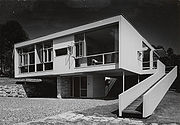

International style
The Rose Seidler HouseRose Seidler House
Rose Seidler House is a Bauhaus-styled home designed by Harry Seidler located at 71 Clissold Road, Wahroonga, a suburb of Sydney, New South Wales, Australia. It is managed by the Historic Houses Trust of New South Wales as a museum that has been open to the public since 1991. Built in 1949-1950, it...
built by Harry Seidler
Harry Seidler
Harry Seidler, AC OBE was an Austrian-born Australian architect who is considered to be one of the leading exponents of Modernism's methodology in Australia and the first architect to fully express the principles of the Bauhaus in Australia.Harry Seidler designed more than 180 buildings and he...
for his parents between 1948 and 1950 in Sydney incorporated Modernist features of open planning, a minimal colour scheme, and labour saving devices that were new to Australia at the time. The house won the Sir John Sulman Medal
Sir John Sulman Medal
The Sir John Sulman Medal is a New South Wales architectural prize presented by the Royal Australian Institute of Architects and was first awarded in 1932....
in 1951 and is today preserved as a museum as a very influential house.http://www.hht.net.au/museums/rose_seidler_house/rose_seidler_house
After the second World War
World War II
World War II, or the Second World War , was a global conflict lasting from 1939 to 1945, involving most of the world's nations—including all of the great powers—eventually forming two opposing military alliances: the Allies and the Axis...
, architects in Australia were influenced by the development of the International style of architecture. Some regional variations developed. In Melbourne, Robin Boyd
Robin Boyd
Robin Gerard Penleigh Boyd CBE was an influential Australian architect, writer, teacher and social commentator...
and Roy Grounds
Roy Grounds
Sir Roy Burman Grounds , wasone of Australia's leading architects of the modern movement.-Biography:Born in Melbourne, Grounds was educated at Scotch College and then Melbourne University and worked for the architectural firm of Blackett, Forster and Craig...
articulated a Melbourne interpretation of the modern style. Boyd's book Victorian Modern (1947) traced the history of architecture in the state of Victoria and described a style of architecture that he hoped would be a response to local surroundings as well as the popular international style. In particular he nominated the work of Roy Grounds and in some outer suburban bush houses of the 1930s as being the early stages of such a style. Grounds and Boyd later worked in partnership.
The houses were typically narrow, linear, and single storey with a low pitched gable roof. They had exposed rafters and wide eaves. Walls were generally bagged or painted brick and windows were large areas of glass with regularly spaced timber mullions.
L-Shape 1945 - 1955
This style represented a change in the overall floor plan, the plan resembling a large "L" Shape. Usually with gabled ends to the L, with terra cottaTerra cotta
Terracotta, Terra cotta or Terra-cotta is a clay-based unglazed ceramic, although the term can also be applied to glazed ceramics where the fired body is porous and red in color...
tiles still being used, as concrete
Concrete
Concrete is a composite construction material, composed of cement and other cementitious materials such as fly ash and slag cement, aggregate , water and chemical admixtures.The word concrete comes from the Latin word...
tiles didn’t appear until the late 1960s. Timber or steel framed windows were used, and front-facing fences resembled the house, much the same as had been seen since the Early Modern Period.
Triple front (cream brick) 1950 - 1960s
Distinctly recognisable by their front-facing walls have 3 and sometimes even 4 front-facing falls. This led to the front entrance sometimes brought round to the side within one of the alcoves created by the multiple fronts. Roofs were medium pitched and hipped with concreteConcrete
Concrete is a composite construction material, composed of cement and other cementitious materials such as fly ash and slag cement, aggregate , water and chemical admixtures.The word concrete comes from the Latin word...
tiles being used towards the end of the style in the late 60s. Front fences had a castellated top and feature piers raised above the top of the rest of the brick fence. Decorative iron
Iron
Iron is a chemical element with the symbol Fe and atomic number 26. It is a metal in the first transition series. It is the most common element forming the planet Earth as a whole, forming much of Earth's outer and inner core. It is the fourth most common element in the Earth's crust...
was used very minimally, in gates to driveways, and balustrades to entrances.
Late twentieth century 1960 - 2000
Styles of the late 20th Century have largely been derived from the current world architectural trends, or have been imitative of previous Australian styles. These styles include Stripped Classical, Ecclesiastical, International, Organic, Sydney Regional, Perth Regional, Adelaide Regional, Tropical, Brutalist, Structural, Late Modern, Post Modern, Australian Nostalgic and Immigrants' NostalgicA good cross section of Australian residential architectural styles from this period, although not necessarily falling into one of the categories above, follows. Almost all of the houses shown in this section were built after 1960 and photographed just North of Sydney on the Central Coast of NSW.
Each of these styles has a different emphasis to practicality (physical needs, layout, and views), land and environmental considerations (structural requirements for foundations, design for weather protection) and aesthetic considerations (planar, volumetric, and sculptural form, emotional and spiritual qualities.) All of these requirements and qualities should be considered when designing a house.
Painted and rendered triple fronted brick veneer
This style of house has a brick facade (exterior) with timber frames supporting interior walls, usually of gyprock. Roofs are always hipped or gabled and tiled. As mentioned previously in this article, this style, without the painted and rendered brick facade, dominated suburban architecture in the 1950s - 1960's. In its basic form it is a bland and unimaginative style which has been propagated by developers. Due to its familiar and cheap construction, it still is the dominant style in housing estates and many consider the style the scourge of Australian domestic architecture. The basic style has been made more interesting by rendering and painting, adding more angles, porticos, verandahs, and bay windows. large homes, 2 story homes of this style have been described as "McMansionMcMansion
McMansion is a pejorative term for a large new house which is judged as pretentious, tasteless, or badly designed for its neighborhood. Alternately, a McMansion is a large house in a sub-division of similarly large houses, which all seem mass produced and lacking distinguishing characteristics, and...
s".

Timber and fibro fisherman's cottage
The original fisherman's cottage was built in many coastal towns between the 1930s and 1950s. It was originally a simple timber framed structure of one or two rooms and a verandah which was clad with asbestos sheeting. The floors were generally raised on piles. The verandah sometimes had handsome wooden balustrade that was sometimes enclosed to make an additional room or sleep-out. Timber detail around windows and gables were often painted- cheery red being one of the most popular traditional colours.The original cottages, being relatively cheap to purchase, are now popular for renovation. Construction is easy and owner-building is common. The older buildings require insulation in the ceiling and walls. Timber and fiber cement sheeting now replaces the original asbestos and often the interior is completed gutted to create a modern open plan style of living. Timber strap-work can be used and windows frames painted for effect.
Regional gabled cottage
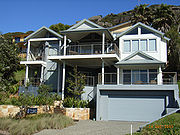
While it is well suited to sloping blocks, this style can also be built on a slab. The use of timber cladding greatly reduces weight and construction costs
Ranch style
The ranch style became popular in the nineties. It originated in Adelaide and subsequently became popular in regional and coastal NSW. The floor plan is simple and footprint (of at least the street facing section) is often rectangular. Walls are usually brick, or brick and timber, and windows are often colonial style floor-to-ceiling. Roofs usually tiled with extended eaves. The garage was often integrated into the house. Some ranch style houses were boomerang shaped, others were L shaped for corner allotments.Ranch style houses can be readily combined with the Murcutt/Drew style (timber and galvanized iron). These smaller ranch style houses often have balconies the width of the house.
Murcutt/Drew steel and corrugated iron house

Pavilion style
The Pavilion style house is characterized by a simple rectangular, box shaped volumetric style, open plan interior with glass replacing much of the wall space. Windows are often also steel framed. The transparency of the walls makes it well suited for blocks with privacy and/or views. Open patios are an integral part of living area, and like the rooms, they are orientated according to the aspect. Roofs are often low pitched roof and skillion. The style was a favorite of architect Harry Seidler who favoured walls of rendered brick however it is also well suited to a steel, fiber cement, and corrugated iron treatment. This approach often requires the thinness of steel framing to create the desired look.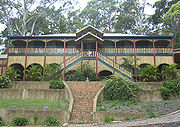
Queenslander style (Australian Nostalgic)
The Queenslander style house is characterized by an all timber painted exterior, a timber stud frame, and a floor raised on piles for air flow in hot climate. They have wide verandahs (often the length of the house and enclosed by shutters, and roofs are gabled and corrugated iron. The street facing view is often symmetrical. The NSW Queenslander is often smaller than the original classic Queenslander and is less decorative probably due to limited supply of delicate timber detail and trades-people to build them. It is sometimes combined with the Ranch style house.Contemporary Styles
Contemporary styles from 2000 onwards include post modernism, modernism and pop architecture.
Adaptive

Some notable examples include:

